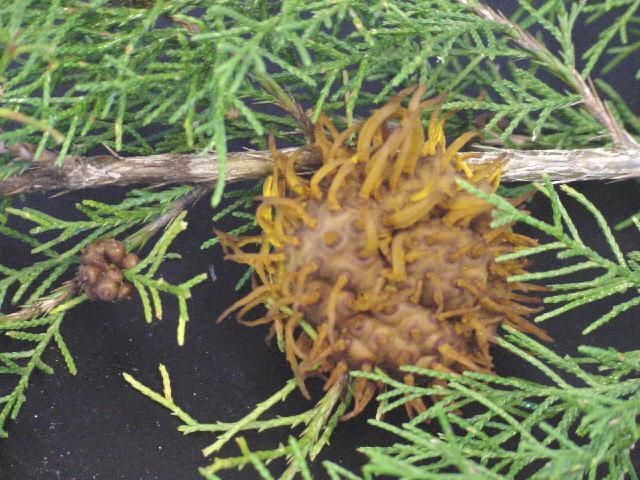
by Matthew Orwat | Jul 8, 2014

Cedar-Apple rust or Cedar-Quince rust (Gymnosporangium) symptoms on pear fruit. Image Credit Shep Eubanks, UF IFAS.
This is the season for fruit harvesting, particularly for those fruits in the rose family such as plum, quince, peach, pear and apple. Many avid home horticulturists have been enjoying the fruits of their labor, but some have been thwarted by an unlikely and ugly disease.
This fungal disorder, commonly called cedar-apple rust and caused by various species of Gymnosporangium, has the potential to ruin Quince, Pear and Apple crops in gardens throughout Northwest Florida. Early scouting and vigilance will pay off.
This condition begins on native juniper species (known as cedars). A spore producing gall forms on the branches of the cedar tree, which begin to produce spores during wet weather. Spores, once produced, can travel up to a mile via wind. If spores land on susceptible plant tissue when a film of water is present, it will germinate and infect the fruit, twig or leaf. Although black spots develop on the plant with in 7-10 days of infection, orange tubes called aecia won’t develop until 4 or more weeks after infection. Next, spores are released from the aecia located on the fruit tree and travel to infect new juniper plants . The infected junipers will not show symptoms until the next growing season but they can manifest as galls or orange ooze present under bark. Different species of Gymnosporangium will infect trees differently. Some live only for one year while others, known as ceder-quince rusts, can last up to 20 years. Twigs infected with this disease usually die within several years of infection.
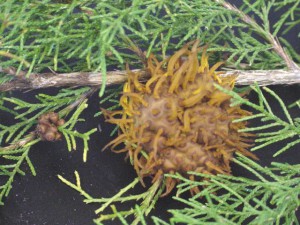
Ceder-Apple Rust on infected juniper host species. Image Credit Hank Dankers UF IFAS.
Although this may seem like an impossible situation, several control strategies exist.
- Remove Infected branches: Removal of infected plant tissue will reduce the spread of the disease in your garden.
- Removal of infected juniper host species: If the juniper or “cedar” in your landscape is something you can sacrifice, removal is warranted in cases of heavy infection.
- Avoid planting susceptible species of juniper next to susceptible fruit tree species.
- Treatment of fruit trees with fungicide: Preventative fungicidal sprays of products containing the active ingredients of sulfur, captan, chlorothalonil, or mancozeb and similar products can be effective. They will not cure existing conditions but are useful if you know that rusts are present in your area. Please read all pesticide labels before application, since there are pre-harvest limitations present on some products.
For additional information, please consult you local county extension office or review these publications by UF IFAS specialists (Florida Plant Disease Management Guide) and the Missouri Botanical Garden.
by Julie McConnell | Jul 1, 2014
Panhandle residents have seen caterpillars in abundance this June. One common visitor to pecan trees is the Walnut Caterpillar Datana integerrima. The walnut caterpillar has a very narrow host range and feeds only on trees in the Juglandaceae family which includes walnut, pecan, and hickory trees. They are sometimes seen on other plant material, but feeding on non-host plants is unlikely.
Walnut caterpillar feed on the leaves of host trees through several growth stages and molts until they have reached the final larval instar and are ready to pupate into an adult moth. Their color changes from light green when newly hatched to reddish-brown to almost black with long white hairs as they mature. The caterpillars group together in large masses and may hang from each other and dangle from the tree branches when molting. Instead of creating a cocoon in the tree, the walnut caterpillar moves to the ground beneath the tree and burrows into the soil or leaf litter to pupate and emerges later as a moth.
What can you do if your pecan tree is hosting walnut caterpillars?
Although the numbers seen on trees may be alarming, a healthy tree can tolerate some feeding damage. Stripped branches may increases the chance of a lower yield of fruit because the removal of leaves does reduce the amount of energy the tree can produce, but overall health of the tree should not be significantly affected. However, many homeowners find falling caterpillars and their excrement unappealing and may decide to take steps to manage the population.
There are several natural enemies that feed on caterpillars, so avoid using a broad spectrum insecticide that might harm predatory insects and other animals. Consider using a biological control product such as Bt (Bacillus thuringiensis) that is only lethal to caterpillars. Other methods are “pick and squish” or drowning in a bucket of soapy water. Next year, in the spring, watch for masses of tiny green eggs on the underside of leaves and remove and destroy them before hatching.
For more information visit USDA Forest Service Forest Insect & Disease Leaflet 41 “Walnut Caterpillar”
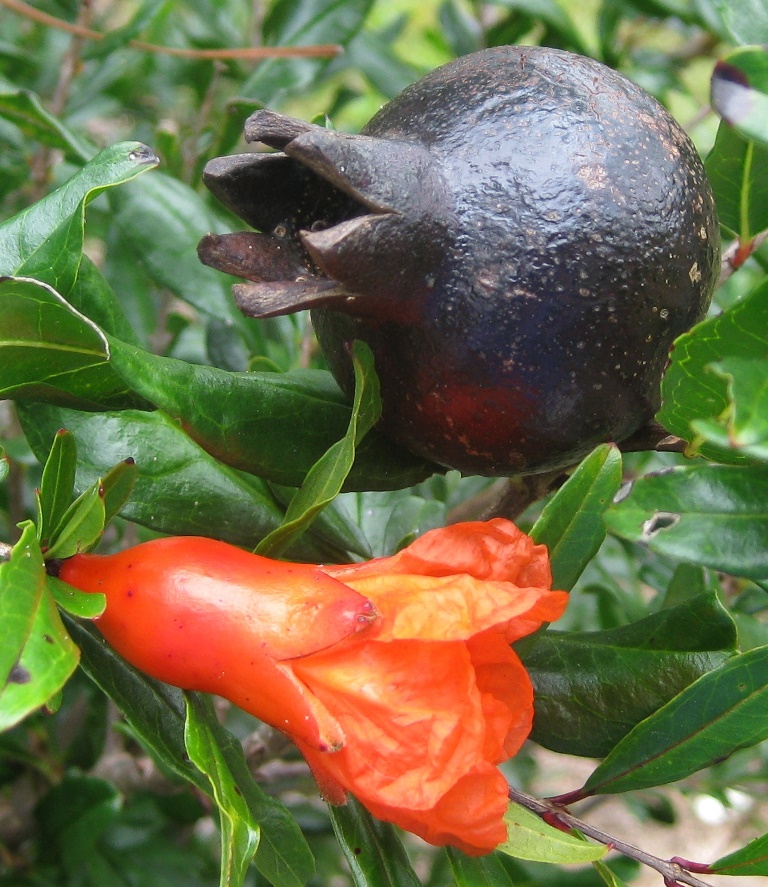
by Gary Knox | Jun 17, 2014
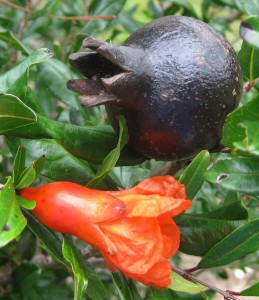
Orange flowers and purple fruits often occur on Purple Sunset pomegranate at the same time, producing a colorful display. Photo by Gary Know, UF IFAS.
Purple Sunset is a new ornamental cultivar of pomegranate, Punica granatum. Purple Sunset pomegranate is distinguished from fruiting pomegranate by a bushy, compact habit and numerous flowers followed by small, ornamental, purple-black fruit.
Native to southeastern Europe and Asia, pomegranate has long been grown for its edible fruits. Horticulturists recently recognized its ornamental qualities and began selecting pomegranate for form, flowering, and ornamental fruits. ‘PIIPG-1’ is a cultivar selected from open-pollinated seeds of Punica granatum ‘Nana’. Trademarked as Purple Sunset, this cultivar has a bushy, compact growth habit. Although promoted as a dwarf form that grows only 3–4 feet, plants in north Florida (USDA Cold Hardiness Zone 8b) have grown significantly larger, approaching 6 feet in height 3 years after planting. Purple Sunset pomegranate may be used in the landscape as a specimen plant or hedge.
Leaves of new growth are red-tinged, becoming glossy green throughout summer, and turning yellow to yellow-green in late fall before dropping in early winter. Large two-inch orange flowers occur on new growth throughout summer and fall. The orange flowers develop into inedible, shiny, purple-black fruit up to three inches in diameter. Orange flowers and purple fruits often occur on the plant at the same time, producing a colorful display. Fruits persist into winter, adding interest to the leafless shrub, before eventually falling. Wildlife may eat the tough, seedy fruits, but this has not been documented.
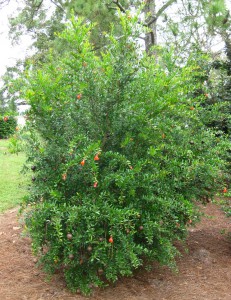
Purple Sunset pomegranate in North Florida. Photo by Gary Knox, UF IFAS.
Culture of Purple Sunset pomegranate is similar to fruiting pomegranate. This plant is hardy in USDA Cold Hardiness Zones 7–10. It grows best in full sun to part shade on deep, loamy soils but is adapted to all but alkaline soils. Pomegranate is somewhat drought tolerant once established. Hedged plants should be pruned in late winter before new spring growth. Leaf spot and fruit blotch, diseases of fruiting pomegranate, may also affect Purple Sunset, but these problems have not been noted in the landscape.
For more information:
The Pomegranate
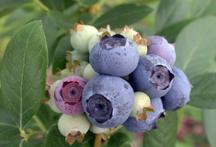
by Roy Carter | Jun 10, 2014

Blueberry. Photo credit: Eric Zamora, UF IFAS.
Blueberries are native to Eastern North America. They are one of the few crop plants that originated here. The rabbiteye blueberry occurs mostly in certain river valleys in Northern Florida and Southeastern Georgia. The high bush blueberry is native to the eastern third of the United States and Southeastern Canada. Florida is rich in other native species. The woods and swamps of Florida are populated with at least eight wild blueberry species. No area of the state lacks wild blueberries, except where soil pH is above 6.0.
The two types of blueberries grown in Florida are Southern highbush and rabbiteye. The earliest ripening southern highbush varieties ripen about 4 to 6 weeks earlier than the earliest rabbiteye varieties grown at the same location.
Some rabbiteye varieties recommended for our area are: Alice blue, Beckyblue, Climax, Bonita, Brightwell, Chaucer and Tifblue. Some recommended Southern Highbush varieties are: Blue Crisp, Gulf Coast, Jewel, Sharpblue, Santa Fe, Star and Misty.
Blueberries need a fairly acid soil; a pH range of 4 to 5 is suggested. Blueberries grown on alkaline or deep sands will grow poorly. If you need to lower the soil pH before planting, mix in some acidic peat moss.
Blueberries have a shallow, fibrous root system. That means plants should be placed in the ground about an inch deeper than they were growing in the nursery. Rabbiteye blueberries grow poorly in soils with excessive drainage. But they won’t tolerate too much moisture for long periods of time either.
Blueberries are very sensitive to fertilizers. During the first growing season, no mineral fertilizer should be added at all. In the second season, apply about two ounces of an acidic fertilizer per plant. Blueberries can use the same fertilizer as camellias and azaleas, but be careful not to overdo it. Excessive amounts of fertilizer will kill the plants.
Before planting blueberries, you should cultivate the soil by plowing or roto tilling to a depth of at least six inches. Dig a hole large enough so that the roots won’t be crowded. Lightly pack the soil around the roots and water thoroughly. Keep in mind that newly set plants need a good water supply.
Bare-root bushes should be transplanted during the winter months; container grown bushes can be transplanted anytime. The first year after planting, the blossoms should be removed to help the bush grow more quickly.
Pruning is an important part of blueberry culture. It promotes the growth of strong wood, and rids the tree of weak twiggy growth. The strong wood growth is necessary for good fruit production.
Believe it or not, the worst pests of blueberries are birds. You need to protect your bushes with some kind of netting, or employ the old fashioned scarecrow to do the job. It you don’t protect your bushes, you can count on the birds getting to the fruit before you do.
Other than birds, rabbiteye blueberries have few pest or disease problems. Powdery mildew can occur on bushes that don’t get full sun, but this problem can be easily controlled with a sulfur spray. Bud mites, thrips, fruitworms, and defoliating insects can sometimes be a problem.
Weeds will compete with young blueberry bushes for nutrients and water, so keep the beds as free of weeds as possible. Mulches are good for controlling weed growth. If necessary, there are herbicides available.
For more information please see:
Blueberry Gardener’s Guide

by Matthew Orwat | May 6, 2014
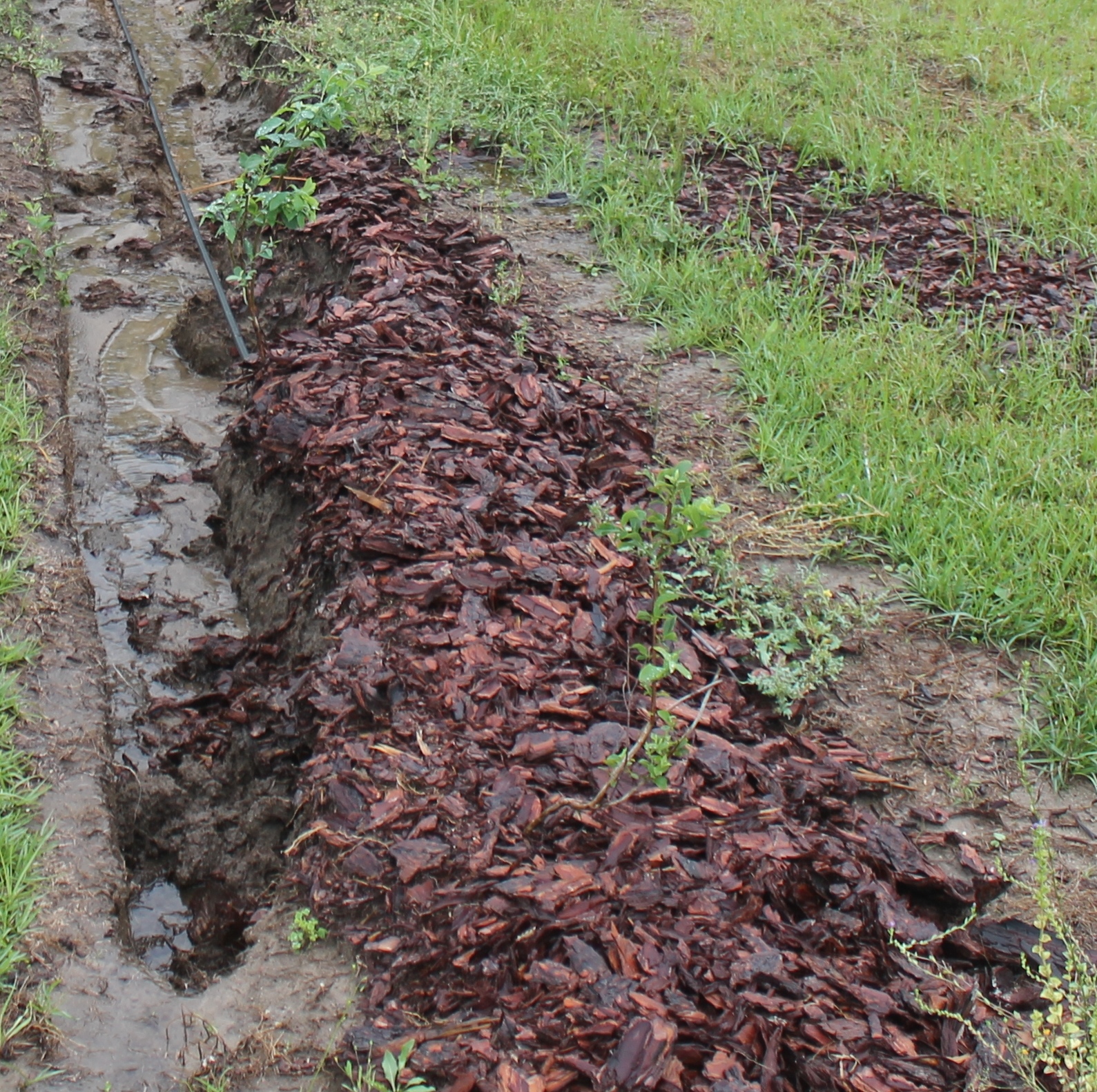
Wash-out in blueberry field, young planting. Image Credit Matthew Orwat

Washed out row in young blueberry field. Image Credit: Matthew Orwat
Although the central Florida panhandle has been hit with excessive rainfall this spring, the blueberry yield this year is on track to be above average. Colder winter temperatures coupled with wet spring weather has enhanced the yield potential of properly tended and well established planted blueberries. If you have a few established blueberry plants in your home orchard, the outlook looks bright. If you do not, don’t fret. There are plenty of U-Pick operations and local farmers market vendors that will have berries available June through July, at great prices!
Blueberries do best planted in low pH soil on slightly sloping ground. This prevents the collection of water and resulting root rot in areas with poor drainage. While this situation is ideal for established blueberry plants, this slightly sloping situation can cause issues for newly planted blueberries. Field wash-outs caused by excessive rainfall can wreck newly planted rows, because the pine bark added to the planting trench is less dense than soil.
After all this rain, what should the home gardener do to ensure a productive harvest this summer? Addition of fertilizer will help. Although blueberries usually require low fertilization rates, if leaves show yellowed edges, red spots or general yellowing, fertilizer may have leached out. Application of a few ounces of ammonium or urea based fertilizer around the root zone (24 inch) of established plants may be beneficial. It is a good idea to look for “Blueberry Special” blends or “Camellia & Azalea” fertilizer. To learn more about blueberry fertilization, consult the Blueberry Gardener’s Guide.
A drier May will help blueberries produce their greatest sweetness as they develop. Late May and June rains could cause fruit split, so less rain during this period is desired!

Blueberries developing for harvest, a month away. Image Credit Matthew Orwat
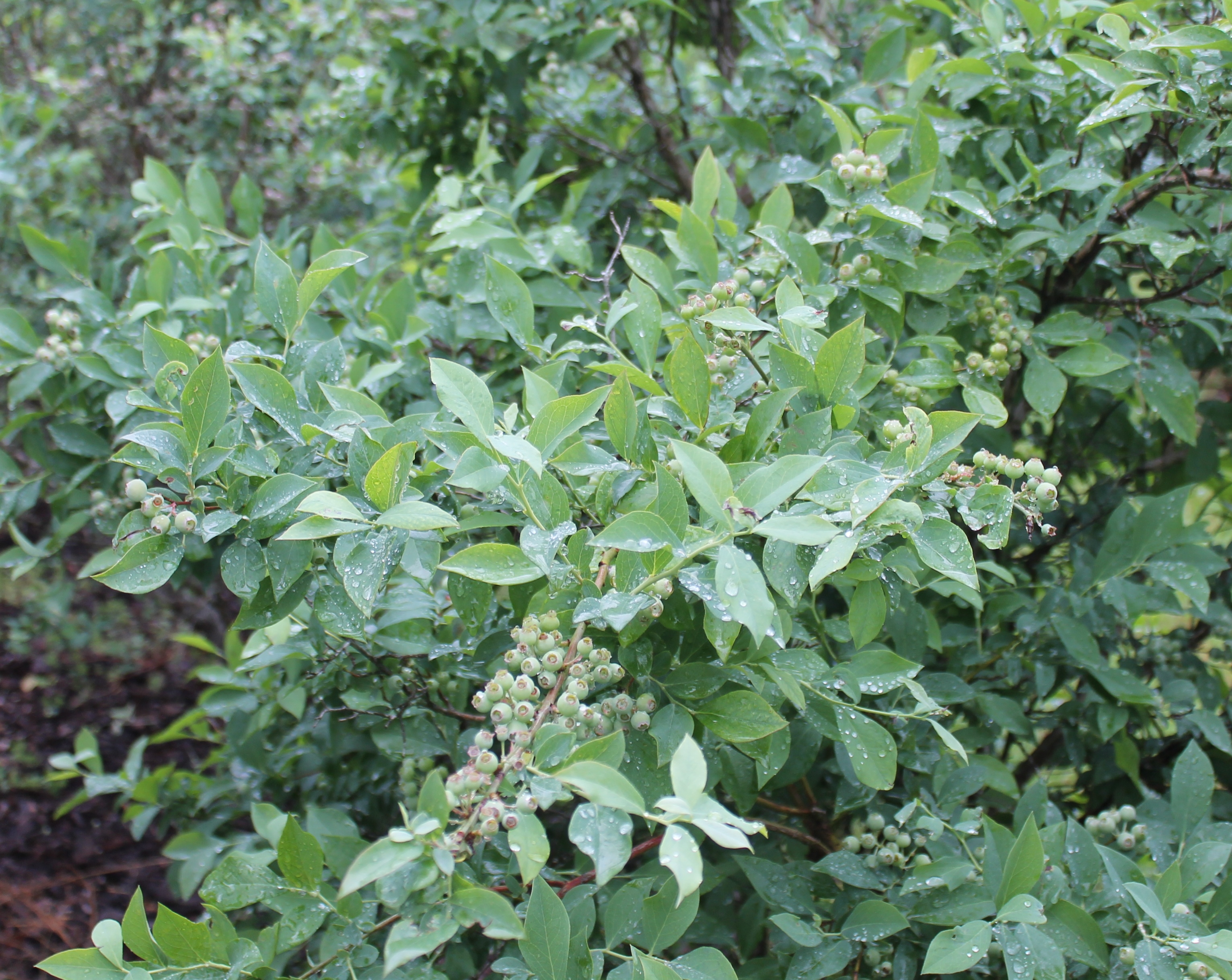
Blueberry bush, full of developing fruit. Image Credit Matthew Orwat

Washed out rows of young blueberries. Note healthy established plants in the background. No washout due to established root system. Image Credit Matthew Orwat

Emergency drainage ditch dug to reduce wash-out damage from field runoff. Image Credit Matthew Orwat
by Larry Williams | Feb 11, 2014

Dormant Peach Tree. Image Credit UF IFAS Environmental Horticulture Department
It is hard to believe with all of this recent cold weather, but now is the time to plant fruit trees in the Florida Panhandle. When planning what type of fruit tree to plant, correct cultivar selection should be the top priority.
The dooryard fruit producer oftentimes finds it difficult to choose the correct fruit cultivar for this area. An inappropriate choice results in disappointment when home gardeners find that they have paid for, planted and cared for fruit trees that are not adapted to the Northwest Florida climate.
Weather is probably the most important factor determining where certain fruits can and cannot be grown.
Most fruits which grow in the northern part of Florida are deciduous, which means that during the winter the trees lose their leaves and go into a period of dormancy, or rest.
During this rest period, the tree must be exposed to chilling temperatures. This exposure to the cold prepares the plant to resume active growth in spring. Temperatures below 45°F accumulated throughout winter determines the total hours of chilling. Species differ in the amount of chilling they need. This is known as a plant’s chilling requirement. Lack of enough chill hours result in sparse foliage and little to no flower production. And if there are no flowers, there will be no fruit.
North Florida receives between 400 to 650 hours below 45°F during the average winter. This provides enough chill hours for a few apple cultivars such as Anna, Ein Shemer, Dorsett Golden, TropicSweet and Shell. However, it does not provide the chill hours required for many of the more common varieties such as Red Delicious and Golden Delicious.
This same environmental factor holds true for most deciduous fruit trees. For example, some of the better known peach cultivars, such as Elberta and Bell of Georgia, perform poorly here following most winters. Both require roughly twice as many chill hours as the Panhandle receives during most winters. There are a few peach cultivars that perform OK in our area.
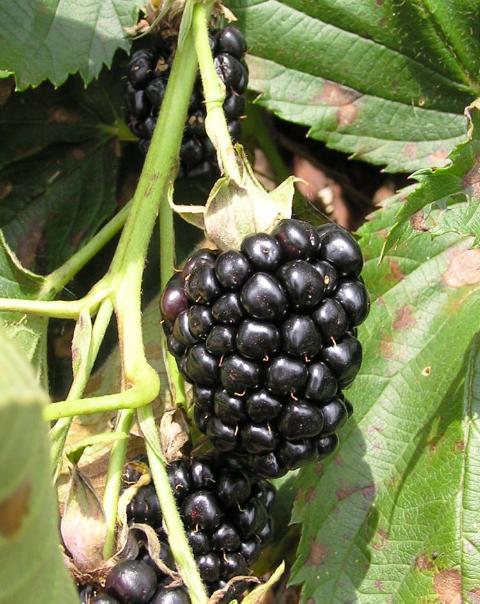
Blackberry Fruit. Photo Credit: Theresa Friday, Santa Rosa County, UF IFAS Extension
The results of selecting the wrong cultivar is only one of the disappointments experienced by those wishing to grow fruits in North Florida. Even when the correct cultivar is selected, many fruit enthusiasts (people who have dreams of homemade peach cobbler, apple pies, plum jelly, etc.) are disappointed to see insects eating their fruit, diseases causing their fruit to rot or possibly all their fruit falling to the ground before it is ready to be eaten.
In order to be successful with fruit production in North Florida, a person needs to ask a lot of questions before planting the first plant.
- Which cultivars grow well here?
- How much care is needed to grow this type of fruit?
- Do I have the time to devote to pruning, spraying, fertilizing and watering?
If you don’t know the answers to these questions, talk to a knowledgeable employee at a local, reputable nursery, consult the Dooryard Fruit Selection publication, or call your UF IFAS Extension Office before choosing to plant fruit trees this winter.















